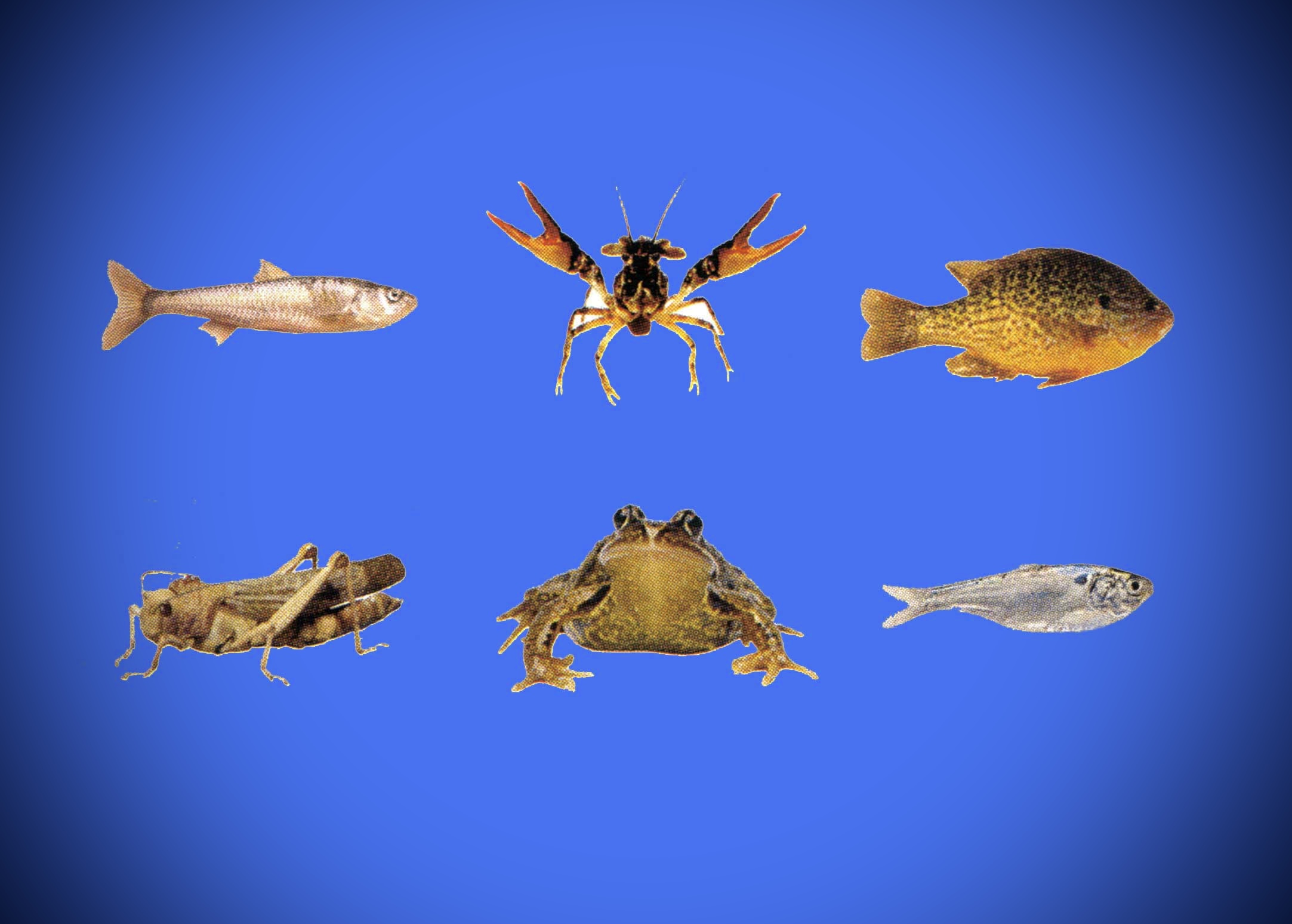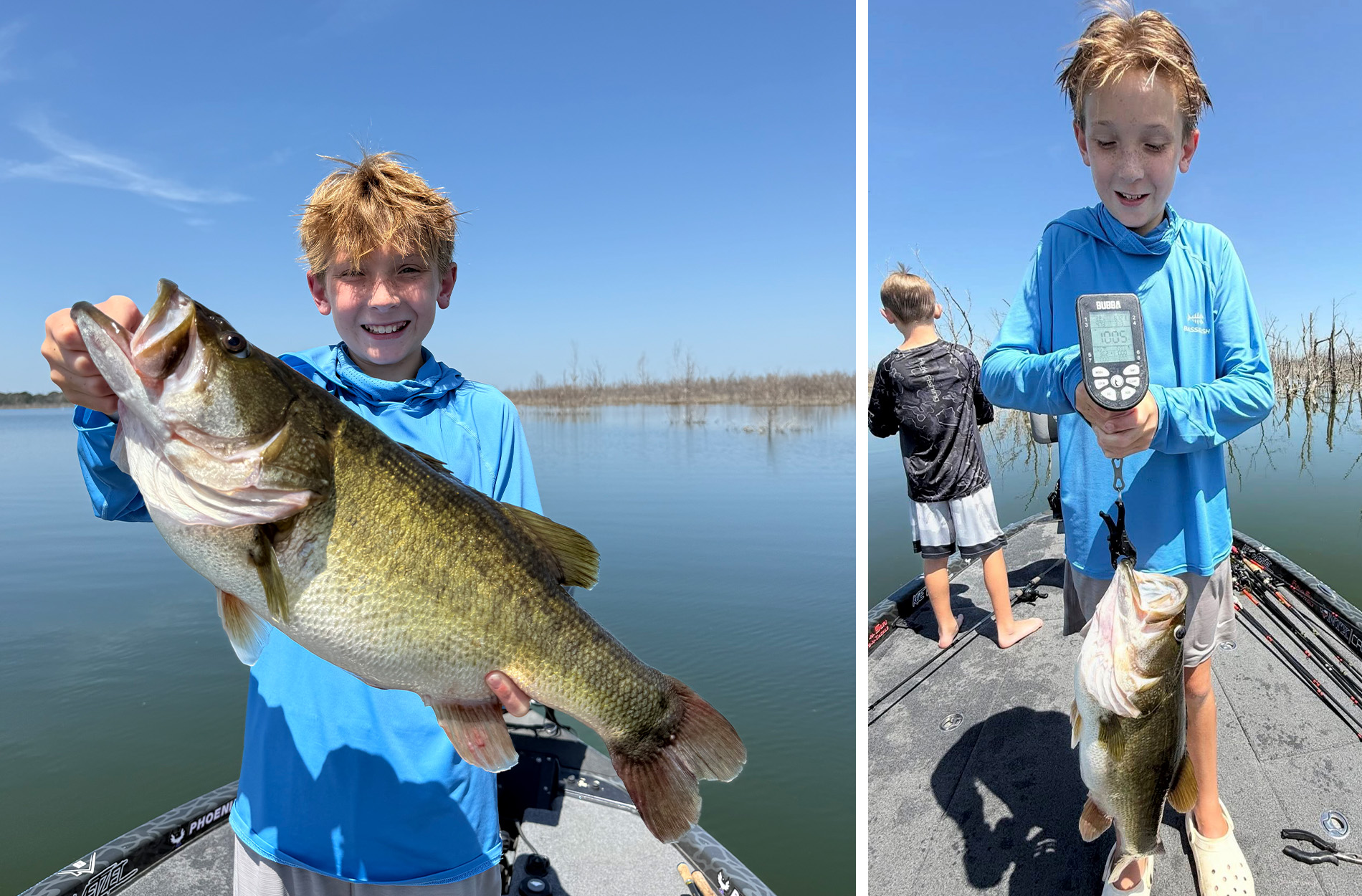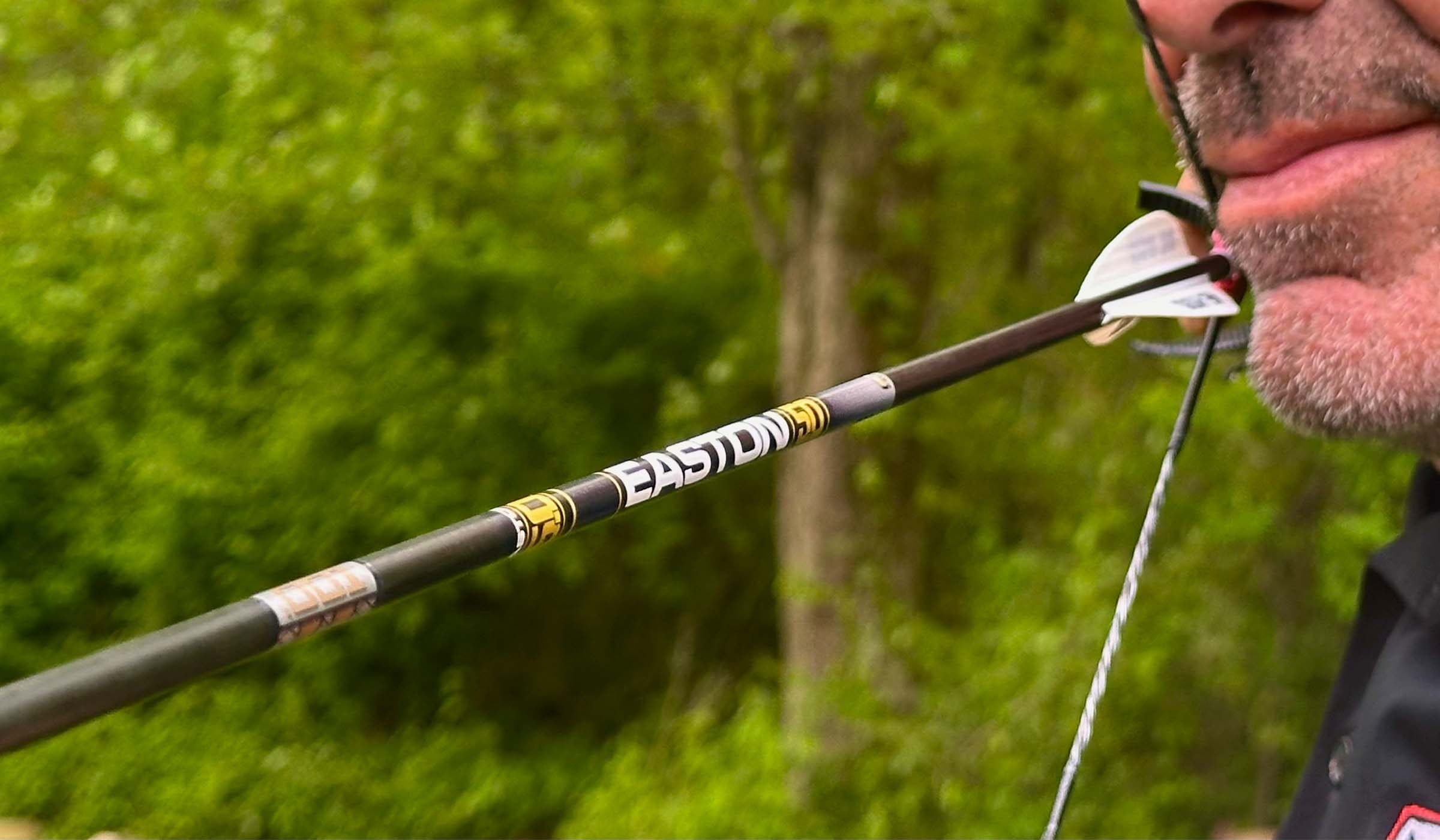Best Barefoot Shoes, Expert Picks for Hiking and Running
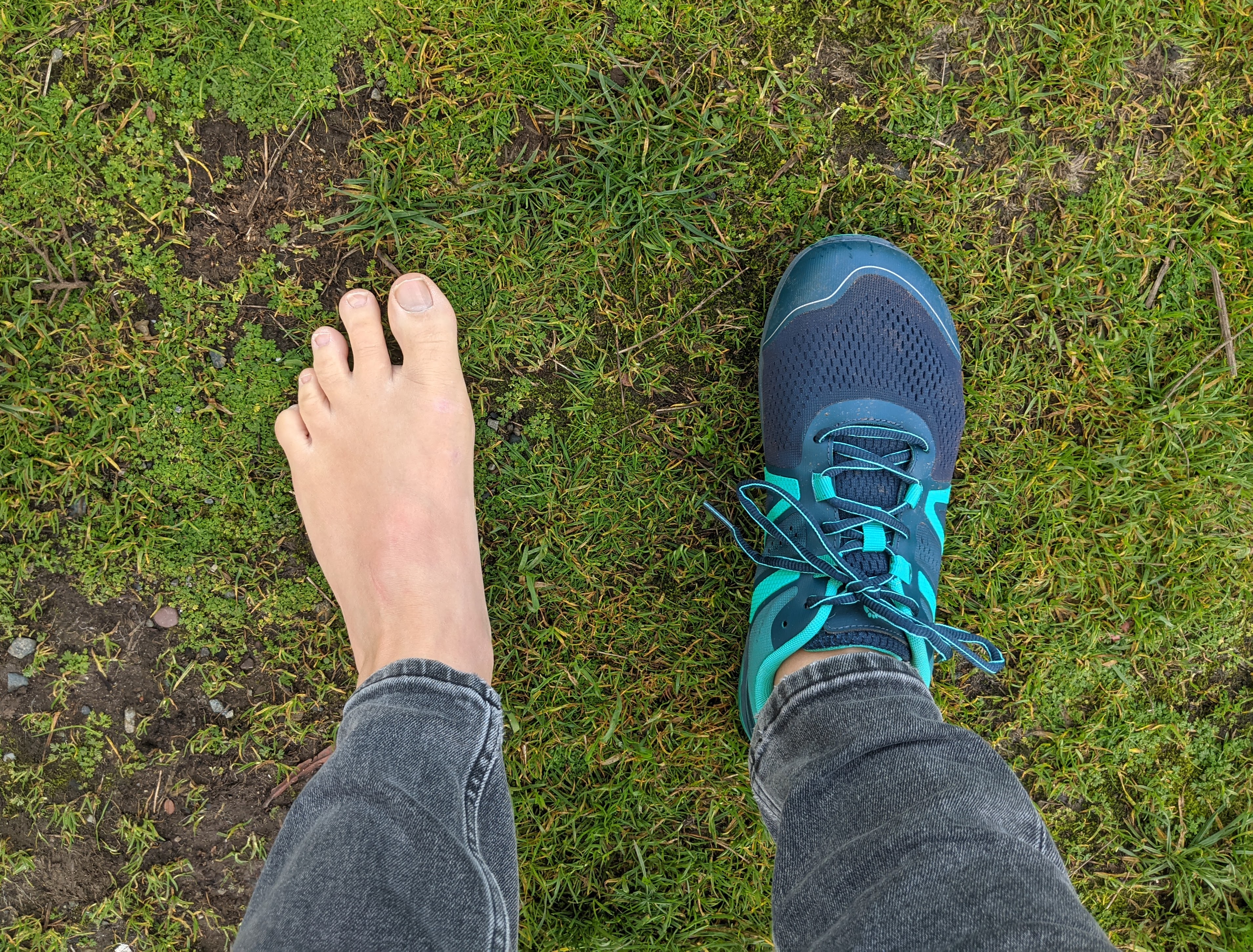
We may earn revenue from the products available on this page and participate in affiliate programs. Learn More ›
I’ve been wearing barefoot shoes exclusively for over a decade, on everything from thru-hikes to winter overnights to hours-long urban hikes. Over the years, my feet have become accustomed to the micro differences between different brands and models, and how or why they fit my feet and needs (or don’t) and might fit your feet or needs. My family also wears barefoot shoes, with my five year old providing feedback on my two picks for kids below.
Read Next: It’s Time to Give Barefoot Shoes a Try
As part of my coverage of footwear at Outdoor Life, I’ve had the chance to help other people start or continue their barefoot journey. This helps to inform my perspective on how different styles and brands of barefoot shoes fit everything from narrow first-time barefooters to extra wide, high-volume feet. If you’re new to barefoot shoes, remember that transitioning takes time. Start wearing your new shoes in limited bursts before ratcheting up the intensity and duration. The more time you give your feet to strengthen and flex, the more surprised you’ll be at what they are able to do and handle.
↓ Jump to Brands to Avoid
↓ Jump to the Best Barefoot Shoes for Kids
↓ Jump to Expert Advice on Choosing the Best Barefoot Shoes
Photo by Laura Lancaster
Buy the Men’s
Buy the Women’s
I wear Vivobarefoots more often than any other barefoot shoe I own. They somehow figured out how to make barefoot shoes that are shaped like feet and look cool, which is not an easy feat. I get more compliments on my Vivobarefoots than any other shoe. But more importantly, they fit my foot like a glove, staying put while still allowing my toes to splay out naturally. I own a half dozen different styles of Vivobarefoots, from daily trainers to hiking boots to Chelsea boots, and they do a great job of maintaining the same fit across different shoe styles. While Vivobarefoots are pricier than other picks on this list, in my experience they hold up better than the lower priced competition and also better than more traditional hiking shoes.
Vivobarefoots aren’t for you if you have a high-volume or wide foot. Because they have a lower stack height, they may not be the right choice for you if you are new to barefoot shoes and are struggling with excessive sensory feedback as your nerve endings acclimatize.
Photo by Laura Lancaster 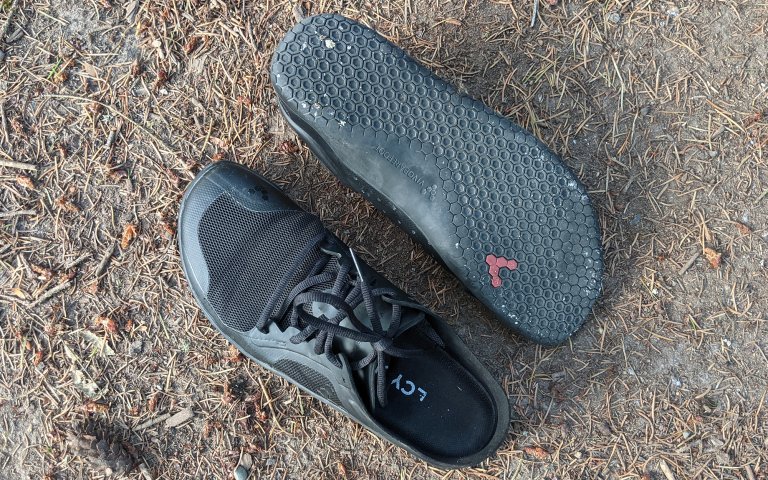
Men’s Sizes
Women’s Sizes
Pros
- Great fit for most feet
- Low stack height has a great minimalist feel
- Robust and long-lasting
- Comes with free access to their barefoot fundamentals course
Cons
- Expensive
- Doesn’t fit as well if you have higher-volume feet
- Visually identifiable as a barefoot shoes
Key Features
-
Weight:
7.9 ounces for a men’s size 9 -
Stack Height:
2mm with 2mm treads -
Removable 3mm insole
User Experience
-
Fits average-width feet -
Intermediate ground feel -
Allows for intermediate toe splay
The Vivobarefoot Primus ticks all the boxes: It has a great foot shape, a low stack height, and is surprisingly robust. I’ve had the same pair now for five years, and while it’s getting a little frayed around the mesh, it’s still plenty serviceable for road running or casual outings. My husband and sister also wear the Vivobarefoot Primus; my daughter wore the toddler version when she was younger.
The Vivobarefoot Primus Lite is narrowest at the heel and fans out toward the toe, with a slope at the front that starts at the second toe. If you have a fairly standard foot, you’ll probably find this shoe’s fit is perfect. But if you have an unusually shaped foot — high volume or wide — then it may feel tight in certain places. (My sister, who helped me evaluate the best hiking shoes for wide feet, wears the men’s version of this shoe.) If this shoe is just a hair too tight, try taking out the insole, which increases the interior volume.
While Vivobarefoot uses the same last — the foot-shaped mold around which shoes are built — for all of their shoes, I’ve found that some models, including the Flow and the Hydra ESC somewhat constrict toe splay compared to the roomier standard Primus. Whenever you’re trying out a new model for the first time, I recommend purchasing them from Vivobarefoots website, to take advantage of their 100-day return policy.
Vivobarefoots are pricier than other barefoot shoes, although not pricier than more conventional footwear. A perk of going with the Primus Lite or any other Vivobarefoot shoe is complimentary access to their “Barefoot Fundamental Course,” which was recommended by the pedorthist I spoke to, Scott Socha. There are a ton of muscles, ligaments, and bones in your foot, and you’ll need to strengthen them to be successful in barefoot shoes.
In my experience, these shoes’ durability justifies their price tag. You’ll easily surpass the 500-mile mark that is standard with cushioned running shoes; I’ve gotten up to 1,000 miles out of some pairs.
Best for Beginners: Xero Shoes
Photo by Laura Lancaster 
Buy the Men’s
Buy the Women’s
Xeros are the perfect Goldilocks shoes for beginner barefooters. They have enough cushion underfoot to avoid feeling the worst of the rocks and roots, but not so much as to truly inhibit ground feel. They run wider along the length of the foot, and have a pretty roomy interior, just about guaranteeing that they’ll fit all but the trickiest of feet. And while these are absolutely a barefoot shoe, they don’t really look like a barefoot shoe. Finally, their price point is eminently reasonable.
Even if you’re a barefoot purist, Xero has such depth and breadth in their lineup that you’re almost certain to find a pair you have to have (mine’s the Alpine).
My Top Xero Pick: Scrambler Low
Dustin Adair 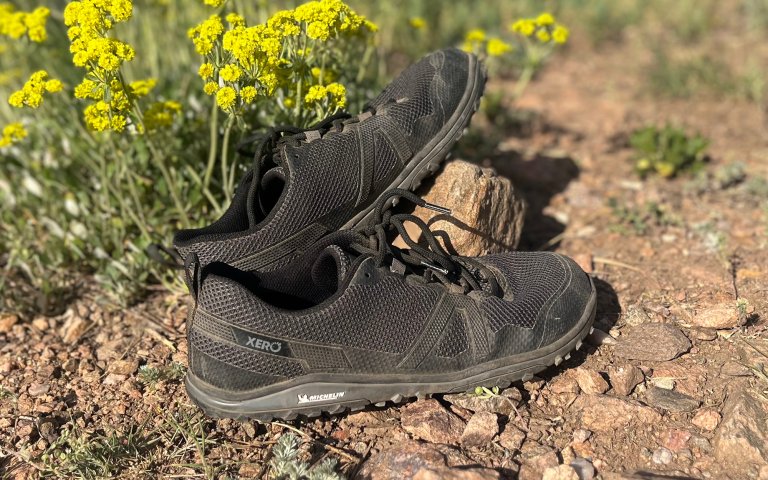
Buy the Men’s
Buy the Women’s
Pros
- Allows for ground feel while protecting against rocks underfoot
- Fits a wider range of foot types
- Great for hiking and trail running
Cons
- Contains 4mm of foam
- High stack height
Key Features
-
Weight:
18.4 ounces for a men’s pair -
Stack Height:
11.5mm -
Removable 3.5mm insole
User Experience
-
Fits wide and high-volume feet -
Moderate ground feel -
Allows for intermediate toe splay
If you’ve never used a barefoot shoe, start with this one. It’s got all the bonafides you expect from a barefoot shoe — zero heel drop, wide toe box, no internal structure — but with a pretty hefty stack height (at least by barefoot shoe standards) that includes 4mm of foam. If you’re used to more classic trail runners like the Altra Lone Peak or the Hoka Speedgoat it’s not going to feel cushioned (quite the opposite), but it is going to protect your feet from feeling the pain of any sharp rocks underfoot.
I originally tested this one out on a runner who had been using Altra Lone Peaks, but was starting to get disillusioned as the shoe strayed from its original natural movement premise and trimmed its wide fit. For him, the Scrambler was the perfect shoe, providing plenty of feedback as to what was underfoot while still being comfortable enough to kick out ten mile runs in the desert of the Southwest. He also found that the shoe’s outsole and lugs had plenty of traction, even when he was running over wet terrain.
The longer you wear barefoot shoes, though, the more the Scrambler will start to feel overly cushioned. When that happens, start by removing the insole (that’s 3.5mm of cushion gone right there). But if you find yourself craving more connection to the ground, then it’s time to move on to either Vivobarefoots (for average-shaped feet) or Softstar (for wide or high-volume feet).
Hikers, take note: While I and other testers have found that Xero’s Michelin outsoles perform well enough in most hiking scenarios, they are not at the level of the likes of the Vibram Megagrip for more technical trails.
Other Xero Shoes I’ve Tested
Best Upgrade: Softstar
These barefoot shoes are pricey for a reason: They are made in the USA. And they are, without question, the best barefoot shoe experience there is, for all foot types. They are comfortable for wide, high-volume feet, and they are secure for average volume, average width feet. I also love the toe splay I get in these shoes. In Softstar, I can spread my toes as wide as they can go and feel no restriction whatsoever from the shoe, even as it stays perfectly positioned on my foot for everything from backpacking to trail running.
Besides the price, the other ding on this shoe is that they look pretty weird, even for barefoot shoes. (The pair I own was once described as looking like “orthopedic shoes”) But no matter: This isn’t the only pair of barefoot shoes you are going to own; it is the pair that you’re going to grab when you want an unparalleled barefoot experience.
Best Upgrade: Softstar Megagrip Primal RunAmoc
Photo by Alex Robinson 
Unisex
Pros
- Incredible toe splay
- Perfect fit for a wide range of foot types
- So comfortable
- Best-in-class Megagrip outsole
- Choose your own colors
- Made in the USA
Key Features
-
Weight:
1 pound, 1.1 ounces -
Stack Height:
9.5mm -
No insole
User Experience
-
Fits all foot types -
Intermediate ground feel -
Allows for maximum toe splay
Where I live, it’s basically impossible to find a flat running or hiking route. Road, trail, it doesn’t matter; expect a minimum of a 10 percent grade if you are going out for more than a mile. In other barefoot shoes, I would shorten my stride and run baby steps down the steepest gravel or wet trails because the traction just wasn’t there. So it was a total revelation to put on the Softstar Primals and be able to fly down the trails. Part of this was the inclusion of the excellent and quite sticky Vibram Megagrip outsole. But having more toe splay than with any other shoe I’ve tested was a major factor too.
While I know individuals with extra-wide and extra-high volume feet who are Softstar devotees, I was impressed that my very typical foot had no issue with slipping around in the Primals. The soft leather the shoes are made out of comfortably hug your foot once they are laced up. They performed admirably on the 2024 Outdoor Life backpacking gear test, where I navigated everything from scree to snow wearing these and never wished for a different pair of shoes. They even worked fine to pull on a pair of the best ice cleats for hiking.
So are there any downsides to the Softstars? Because they are made from leather, you need to take care in unusually wet conditions. (Softstar recommends using Nikwax’s Waterproofing Wax for Leather). And despite being made from leather, they don’t look conventionally stylish, as they have a fairly boxy shape.
Despite the premium materials being used here — leather, Vibram outsoles — and being handmade in the USA, I was impressed that the Softstar Primals didn’t cost particularly more than other premium options I tested. While I would recommend going with something more mainstream for a first-time barefoot shoe wearer, these shoes are a great investment for anyone looking for a better fit or greater freedom of movement.
Best for Foot Strength: Vibram Fivefingers
There was a moment around 2012 when barefoot shoes meant Vibram Fivefingers. They were the only game in town (it’s what I wore for several years in the beginning) and it was a real statement. Not only did these shoes have no stack height and no internal structure — no nothing — they also had five toe pouches for each of your toes. They were unmistakable.
It’s almost impressive how little has changed in the intervening years. I tested a pair out more recently, their KSO EVOs, and was impressed by how close it was to what I remembered from those earlier years. The toe splay was excellent and a breeze to maintain. The fit was glove-like. The ground feel: unparalleled. This was why I fell in love with barefoot shoes to begin with. I wore them a few runs, felt very nostalgic, and then took them off and put them back in my closet.
A lot has changed since Vibram originally came out with the Fivefingers. Vivobarefoot and Lems came on the scene with a mix of performance, outdoor-ready options and cool, stylish options. Xero brought us a mix of stack heights to help acclimatize feet weakened by years of overly structured footwear. Luna and Bedrock perfected the split-toe-style sandal. Barefoot shoes have come a long way.
Is there still a place for Vibram Fivefingers? I think so. What’s unique about Vibram Fivefingers compared to these other barefoot shoes is that they force a lot of changes to how you are running or walking that will help you to build foot strength. Your toes are forcibly spread apart, helping to build flexibility and activate your toe splay. There is so little cushioning under your foot that you will start to land with lighter footfalls. And the feel of these shoes really does approximate being barefoot, so you will more naturally start to stride as if you had no shoe on at all, compared to the heel-striking muscle memory that has built up over time from conventional footwear.
But all this comes with a major caveat: Adjust to the barefoot style, or else. Because these shoes are so unforgiving, the consequences of failing to change your form are pretty steep. Lots of people got injured in the first wave of barefoot running trying to run a fraction of their regular mileage before their feet had sufficiently strengthened up. If you go this route, you have to be fully committed to building foot strength before any other priority. Also, they look ridiculous.
Best Sandal: Luna Middle Bear
Photo by Laura Lancaster 
Unisex
Pros
- Comfortable footbed
- Padded back heel strap
- Deep lugs
- Vibram Megagrip outsole
Cons
- Y-strap gets twisted easily
- Adjusting the back heel strap takes some torque
Key Features
-
Weight:
14 ounces -
Stack Height:
9.4mm + 4.5mm lugs -
No insole
User Experience
-
Fits all foot types -
Moderate ground feel -
Allows for maximum toe splay
From the Bedrock Cairns to the Xero H-Trail, there are a number of excellent options out there for barefoot sandals. But after testing some of the top models for a year, the pair that I go back to again and again are the Luna Middle Bears. What’s most noticeable about this sandal is how soft and comfortable the footbed and webbing are, whether I’m wearing the sandals loose for a day at the beach, or strapped down tight to chase down my kid when she zooms off on her bicycle. This is by far the best barefoot sandal for running that I’ve tested to date, with a padded back strap and zero hot spots.
Plan to give yourself a few minutes when you first get this sandal to adjust the webbing correctly to your foot. In my experience, this was a bit of a bear to do the first time, but once the heel strap was the right length it was easy enough to loosen or tighten the main strap on the go. What continues to be annoying, however, is that the webbing used for the Y-straps (the bit in between your toes) tends to twist around, and, every so often, you have to spend a few minutes twisting it back again. But these are all minor quibbles. These are a great choice for barefoot sandals that can be used for a wide range of purposes.
Best for Narrow Feet: Merrell
Merrell gets credit for being one of the only mainstream shoe companies to stick with barefoot shoes when our current maximalism death spiral really got going. But, because their footwear is more mainstream, there are some important differences to their barefoot lineup to be aware of.
The most important of these is that not all of their so-called barefoot shoes are actually barefoot shoes. Some, like the Trail Glove, have tapered toe boxes. Others, like the Wrapt, have arch support. What gives, Merrell? For this reason, most people who are serious about barefoot shoes don’t bother with Merrell. Every so often one of their shoes is gold (I loved the OG version of the Trail Glove) but, like so many mainstream shoe companies, they are constantly retooling their existing models so you can never count on the next generation of a shoe to have the same magic as the original.
The other distinction, and the reason we are talking about Merrell at all, is that they are one of the few barefoot shoe brands that are making shoes for narrower feet.
My Top Merrell Pick: Vapor Glove
Laura Lancaster 
Buy the Men’s
Buy the Women’s
Pros
- Very lightweight
- Vibram outsole
- Comfortable upper
Key Features
-
Weight:
9.2 ounces -
Stack Height:
8mm -
No insole
User Experience
-
Fits narrow feet -
Intermediate ground feel -
Allow for a little toe splay
If, like me, you have average width feet and have been wearing barefoot shoes for a while, then don’t bother with this one. But if you identify as having an especially narrow foot, or are struggling to acclimatize to the wide toe boxes of other barefoot shoes (you’ll get there), then the Vapor Glove is a reasonably affordable alternative to look at.
I had a narrow-footed serious barefoot runner (he clocked over 125 miles during testing) take out the Vapor Gloves and he came back a fan. While his foot had been excessively sliding around inside of Vivobarefoots, the Merrell Vapor Glove did indeed fit like a glove, hugging his heel and midfoot. Because this tester had been running in barefoot shoes for some time, he did clock the comparatively narrow footbox on the Vapor Glove, and noted that it was restricting his toe splay.
Other pros of the Vapor Glove include the Vibram outsole — superior to the outsoles currently used by Xero or Vivobarefoot — and the ultralight weight of the shoe.
The Best Barefoot Shoes: Brands to Avoid
Astral
This first one isn’t exactly a brand to avoid, per se, but it is one with a confused personality. I’ve been noticing more and more people sporting Astral Loyaks, which are boat shoes complete with drainage holes. But Astral has started marketing them as “minimalist” (apparently this is their top seller now, evidence that barefoot is making a comeback indeed), so I decided to check ‘em out to see what was going on. After taking these out for a spin, I’m not going to recommend Astral Loyaks as one of the best barefoot shoes for a few reasons.
The biggest one is that they have the insole that is adding a lot of unnecessary and uncomfortable arch support, but if you take it out, the stitching inside the shoe makes it uncomfortable to wear on its own. It also has a narrow toebox, similar to what’s going on with the Merrells. We’ve all been conditioned to think this looks better or more fashionable, but it’s taking away from its barefoot mechanics.
Finally, its outsole is designed for watersports, which is great if that’s what you’re doing, but it’s not ideal for hiking. If the idea of the Astral Loyak appeals to you, I encourage you to instead look at Xero’s vast catalogue of similarly styled water shoes. Hopefully in the future, Astral can design a true minimalist or barefoot shoe from the ground up that removes the arch support and expands the toe box (a Vibram outsole would be great too) while keeping a similar aesthetic.
Altra
Altra is frequently described as a minimalist shoe. This is not an accurate description, and Altra, when I spoke to them for my story on Altra versus Hoka, told me that they do not see themselves as a minimalist shoe company. While their shoes, particularly the Lone Peak, share many important characteristics, including a wide toe box, zero heel drop (what Altra calls “balanced cushioning”), and no rocker bottom, the substantial foam midsole prevents users from experiencing proprioception, a key tenet of barefoot shoes. However, some individuals who are attempting to transition while race training (which is not recommended by the experts I spoke with), have had luck incorporating their Superior shoe into their training.
Whitin
I was excited to test out Whitin’s barefoot shoes. I wanted to be able to recommend a $45 pair of barefoot shoes. But the pair I ordered, advertised as “Barefoot & Minimalist Shoe | Zero Drop Sole | Trail Runner” just had too many issues with it. First off, it was quite tight, which was a surprise given Whitin’s reputation for making footwear for wider feet. The outsole is also curved at the arch, which was noticeable when I walked in it. Finally, the toebox is very tapered, preventing toe splay.
Peluva
Peluva advertises itself as a zero-drop shoe. This is sort of correct: There is zero drop between the midfoot and the heel. However, there is a 4mm drop between the toes and the midfoot. So while I don’t experience any sort of elevation while standing, when walking I feel slightly pitched forward at all times. Peluva’s explanation for this is that removing 4mm at the forefoot helps to improve articulation of the toes. This may well be true, but it negatively affects your gait and is not a true zero-drop shoe, which is defined as zero drop between the heel and the toes. I suppose it’s a positive sign for the barefoot movement that shoes that are not true barefoot style are attempting to advertise themselves that way.
Xero HFS II
Laura Lancaster 
Men’s Sizes from Amazon
Women’s Sizes from Amazon
Pros
- Xero shoes fit a wider range of foot types than Vivobarefoot
- Do not look like barefoot shoes
- Have waterproof shoes and boots that are appropriate for use in the snow
Cons
- Inclusion of foam detracts a touch from the barefoot experience
Key Features
-
Weight:
16.6 ounces -
Stack Height:
9mm (2.5mm lugs, 2.5mm outsole, 2.5mm foam, and 1.5mm strobel layer) -
Removable 3.5mm insole
User Experience
-
Fits wide and high-volume feet -
Moderate ground feel -
Allow for intermediate toe splay
Something unusual about most Xero shoes, including the Highly Flexible Sole (HFS), compared to other barefoot shoes, is that they do use a very small amount of foam in their soles. When I queried Xero about this, they explained that the reason they use foam in their shoes is to provide protection against the ground without resorting to excessive use of rubber, which would make the shoe heavier. The amount of foam they use in their shoes is fairly negligible, making compression less of an issue over time.
You can’t wear something like the Hoka Clifton indefinitely because the 25mm of foam will eventually compress to 12.5mm. The HFS, which has 2.5mm foam, will compress to 1.5mm, which most people are unlikely to notice. Who may notice, however, are barefoot runners accustomed to the most minimalist shoes like the Vivobarefoot and Vibram FiveFingers. Like with the fit, this ultimately comes down to personal preference, and Xero shoes were recommended by a number of barefoot experts that I spoke with. If you like the fit of the Xero shoes, but not the slight squishiness of the foam, check out either their Speedcross or Prio models, which do not include foam.
Photo by Laura Lancaster 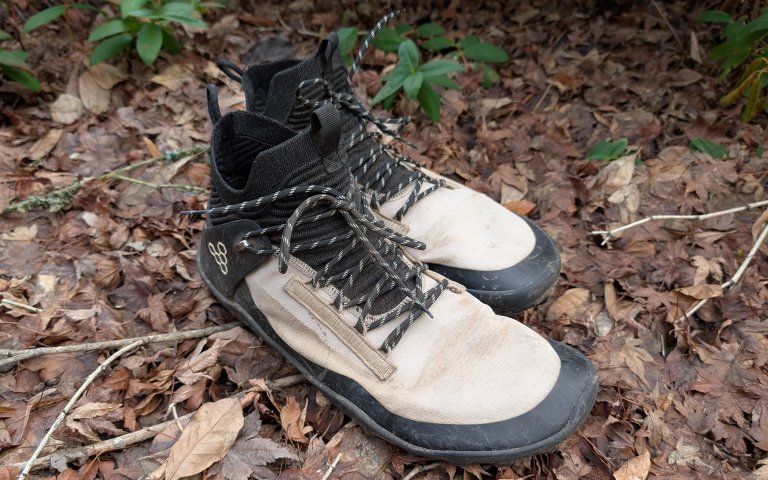
Men’s Sizes
Women’s Sizes
Pros
- Great range of movement, including at the ankle
- Breathable
- Kept out dirt and other debris
Cons
- Expensive
- Slight arch raise built into the outsole aggravated the tester
Key Features
-
Weight:
11.5 ounces -
Stack Height:
7.5mm -
Removable insole
User Experience
-
Fits average feet -
Intermediate ground feel -
Allows for intermediate toe splay
Once you’ve been wearing barefoot shoes for a while, you start to take the freedom of movement for granted. Your toes can spread and your ankles can flex as much or as little as you need them to, basically the opposite of traditional hiking boots, which lock your feet into place and massively reduce ankle mobility.
On the latest backpacking gear test, Adam Tycaster, who has been wearing barefoot shoes for over a decade, tried out the Vivobarefoot Magna Lite. This was his first time wearing a high-top boot in nearly as long, and he came away impressed with its performance on tricky trail conditions. He had plenty of space in the toebox to splay his toes, excellent traction and ground feel, and full ankle mobility, thanks to extremely flexible material in the upper. But what he was most impressed by was how effective the Magna Lite was at keeping out dirt and debris. “I never had dusty or dirty toes the entire trip,” Tycaster said.
One ding for the Vivobarefoot Magna Lite is that the outsole slightly curves up around the arch. While this isn’t exactly the same as arch support, which involves extra cushioning at the arch, it can still interfere with the functioning of the arch. “It doesn’t hobble me or stop me from going full speed,” Tycaster reported. “But I feel a difference in the arch that doesn’t spark joy.”
Finally, while the Magna Lite features Vivobarefoot’s thermal insole, our tester found that even in summer, it didn’t provide enough insulation to comfortably cross lingering snowfields.
Xero Alpine
Photo by Laura Lancaster 
Men’s Sizes
Women’s Sizes
Pros
- One of the warmest barefoot shoes I’ve tested
- Flexible upper doesn’t inhibit gait cycle
Cons
- Waterproofing eventually starts to wear off
- Textured ruff collects snow
- Outsole isn’t ideal for snow or ice
Key Features
-
Stack Height:
7.5mm -
Weight:
1 pound, 12.6 ounces -
Removable insole
User Experience
-
Fits wide and high-volume feet -
Moderate ground feel -
Allows for intermediate toe splay
At this point, I have a half dozen shoes that I’ll alternate between during the summer and shoulder seasons. But if there is snow on the ground, there is only one barefoot shoe I’m putting on: the Xero Alpine.
These are the only barefoot-style shoes I’ve tested that actually protected my feet from the cold of the ground while providing the full range of motion I’ve come to expect from barefoot shoes. I originally tried them out on an overnight snowshoe to Mowich Lake in Mount Rainier National Park. That trip saw temps dip well below freezing. I wore all my layers from dawn to dusk, but in the Xero Alpine, wearing nothing more than a single pair of ski socks, my feet were warm until well after the sun finally disappeared.
In that initial test, my feet stayed completely dry for over 14 miles of snowshoeing. They’d be fine to trek through a mountain stream, I just wouldn’t stay there longer than you need to. (Over time, the waterproofing has slightly worn off, so plan to reup it depending on the conditions you’re expecting).
I did note, however, that the textured ruff at the top of the shoe had a tendency to collect snow, which would then stick to my leg and eventually melt. While this moisture didn’t travel further down the shoe (or impact my legs, which were protected by multiple other layers), it did mean that when I tried to leave the tent for a bathroom break in the middle of the night I found that my shoes were frozen in place, and it took some elbow grease to wrench them apart enough to slip back on.
Finally, while the Xero Alpine has more substantial lugs than other Xero shoes I’ve tested, I would prefer it to have a higher performing outsole than the Michelin one, such as the Vibram Arctic grip found in many of the best winter hiking boots.
Parkinson’s Test Case: Xero Xcursion Fusion
Photo by Ashley Thess 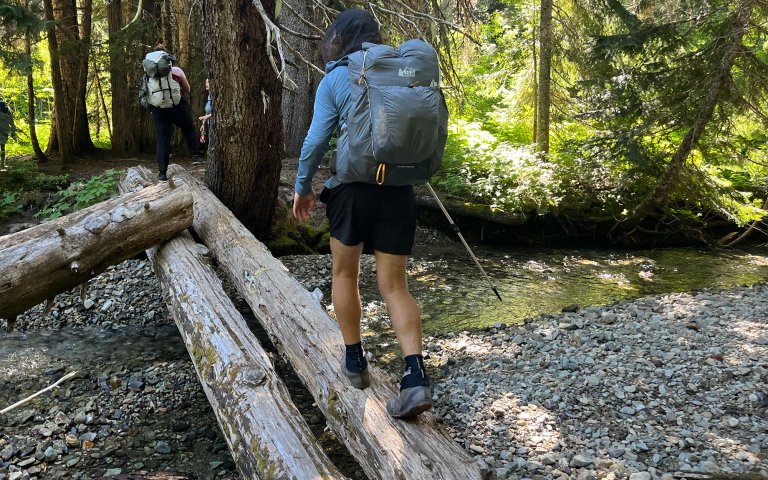
Men’s Sizes
Women’s Sizes
Key Features
-
Weight:
1 pound, 10 ounces -
Stack Height:
13.5mm -
Removable 2mm insole
User Experience
-
Fits average feet -
Moderate ground feel -
Allows for intermediate toe splay
A major reason for switching to barefoot shoes for many hikers is their purported health benefits. OL gear tester Sven “Magic” Anderson was one such individual: he’s been hiking with Parkinson’s for a number of years and is well-acquainted with the challenges of navigating his condition while on trail. He’s been wearing Altra Lone Peaks (in wide) on trail, and already walks barefoot when possible.
To see if reduced stack height (the Xero Xcursion Fusion has 15.5mm underfoot compared to the Altra Lone Peak’s 25mm) would help improve his balance, he wore these barefoot shoes on forty miles of the Pacific Crest Trail through the Goat Rocks Wilderness as part of the annual backpacking gear test.
Despite the surface-level similarities between the two shoes, Magic reported that the Xero Xcursion Fusion was significantly more flexible than the comparatively rigid and supportive Altra Lone Peak. While he “enjoyed having more interaction with the trail, boulders and roots,” a side effect of his Parkinson’s ended up making this more of an issue than expected. “I have developed neuropathy over the last couple of years and my feet are more sensitive than they used to be. So it was painful when I stepped directly on small sharp rocks.”
While the lower stack height should have helped improve Magic’s poor balance (another effect of Parkinson’s), he found that the lack of grip from the Xcrusion Fusion’s Michelin sole meant that he was taking smaller steps and being extra careful on technical downhill portions of the trek. Finally, Magic reported that while he appreciated how “light, soft and flexible the shoe” was, ultimately the Xcursion (which does not come in wide) was too narrow for his foot.
Compared to the Altra Lone Peak, he was impressed with the quick drying time after river crossings, and how durable the shoe is by comparison.
Freet Feldom
Photo by Laura Lancaster 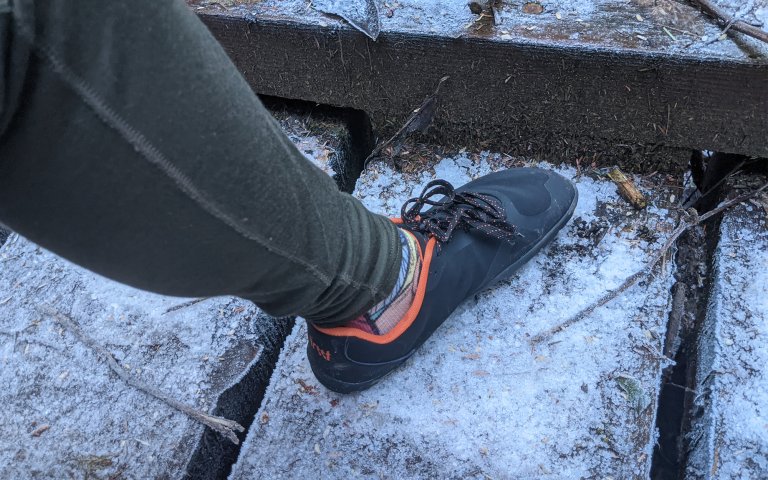
Buy from Freet
Pros
- Very wide, even compared to other barefoot shoes
- Comfortabl
Cons
- Last shape not maintained across the Freet lineup
Key Features
-
Weight:
15.3 ounces -
Stack Height:
8mm (4mm lugs, 2mm outsole, and 2mm foam) -
Removable 2.5mm insole
User Experience
-
Fits wide feet -
Intermediate ground feel -
Allows for intermediate toe splay
A lot of barefoot shoes are wider than average. Turns out when you aren’t trying to control the foot as a way to stabilize it, that opens up a lot of breathing room. As a result, these shoes can often accommodate individuals who otherwise would purchase wide-width shoes — but usually not beyond that. If you’ve got 4E feet, you’re out of luck.
I’ve tested both the Freet Feldom and the Tundra and I’ve found them both to be noticeably wider than other barefoot shoes. If you’ve tried Xero and Vivobarefoot shoes and found that they don’t accommodate the width of your foot, make this your next stop. Unfortunately, Socha shared with me that he’s found that Freet’s last is less consistent than other brands, with their trail running shoe, the Calver running on the narrow side.
| Best Overall | Best Budget | Best for Toddlers |
|---|---|---|
| Xero | Whitin | Vivobarefoot |
| Top Pick: Prio | Top Pick: Kids Wide Barefoot Shoes | Top Pick: Primus Sport |
 |
 |
 |
| Pros: Great colors, wide, reasonable price | Pros: Super wide fit, easy pull on, affordable | Pros: Good variety of options, mini-me versions available, young children can put them on by themselves |
| Cons: Laces are tough for younger kids | Cons: Outsole tread is very lackluster | Cons: Expensive, run small |
Best Overall: Xero
Kids are weird, and they hate shoes. The first time I put a pair of shoes on my kid, after she had started to get the hang of walking, she screamed at me and stood there trying to shake them off. Not a ton has changed in the intervening five years — her most common reaction to a pair of ill-fitting shoes is to throw them across the room — but what has changed is that I’ve discovered the power of color. She’ll put up with the weird feeling of getting used to a new shoe if it’s in a color she likes.
And that’s where Xero’s barefoot shoes really shine. They have a wider selection of colors than just about any other brand — I’m told a silver glitter colorway is on tap in the near future — which means I can pick out something for the kid that she’s excited to wear.
Xero’s kids shoes share similar characteristics to their adult shoes. All the bonafides of barefoot shoes, but with a little more stack height than other brands. And, to boot, a lower price point than more premium brands like Vivobarefoot.
My Top Xero Pick for Kids: Prio
Photo by Laura Lancaster 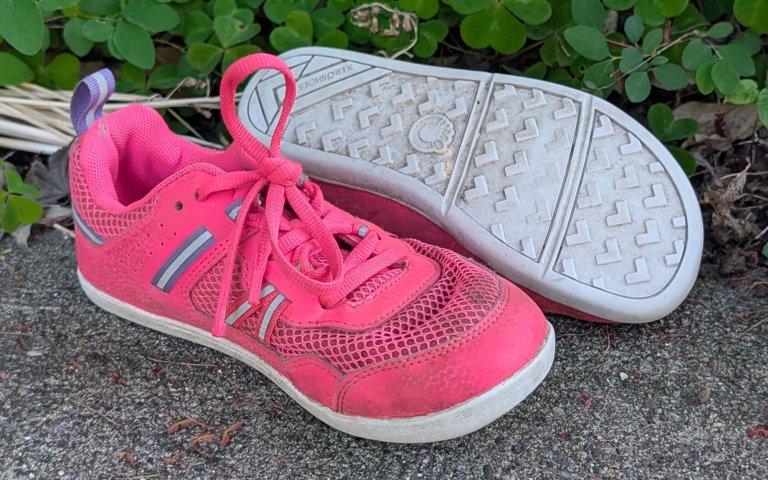
Buy from Xero
While my kid struggles a bit with the lace-up Prios (that bit of knot-tying is a work in progress), she’s reported back to me that she prefers these shoes over the narrower Dillons. The Prios also have a pull tab in the back, which is handy for the littles when they are getting the hang of pulling their shoes on. Note to parents: the shoelaces will go first.
Best Budget: Whitin
After having such a poor experience with the Whitins adult shoes, I wasn’t sure what to expect from their kids’ model. To my surprise, it quickly became one of her favorites. It’s got a wide fit, especially at the toebox, which is perfect for a kid that has only ever worn barefoot-style shoes, and it’s easy for her to pull on. And unlike the adult model, it’s not faffing about with faux arch support stemming from the design of the outsole. It’s a solid, simple, barefoot style shoe.
Photo by Laura Lancaster 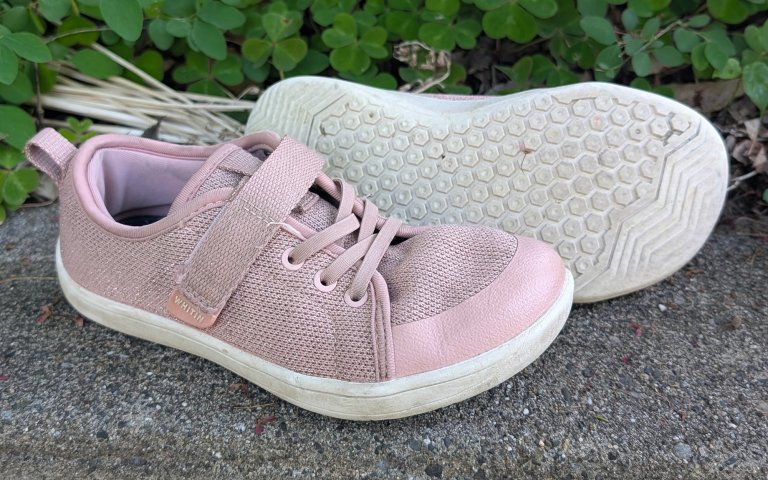
Buy from Amazon
And it’s sure to become one of my favorites, too, given how much money gets spent replacing kids shoes with bigger sizes every six months.
Vivobarefoot is the best choice for your toddler because they actually make toddler-sized shoes that are barefoot style, very flexible, and tough enough to withstand a beating from the more adventurous little explorers. That’s the good news. The bad is that they are pretty pricey for something your kid is going to outgrow in six months or less. Put them in Vivos until they are big enough to wear a Xero or a Whitin and then switch over.
The Primus Sport III is what I had my daughter wearing when she was a toddler, and more recently gear editor Scott Einsmann had his toddler try them. He had been struggling to find a toddler shoe with a more flexible bottom — many of the options for young children have very stiff bottoms which can negatively impact ground feel. Like mine, his kid took to them quickly, putting them through the wringer in creeks and on hikes near their home in North Carolina.
Photo by Scott Einsmann 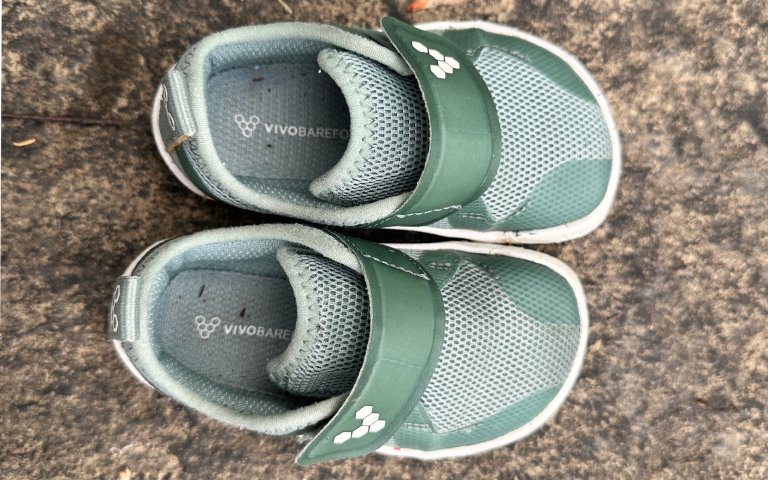
Buy from Vivobarefoot
Something that I appreciate about Vivobarefoot is that they make adult and toddler shoes in the same style and the same color. When my child was around two she was quite enamored with having a mini-me style shoe. And when that independent streak kicked in, being able to put these flexible, easy-open, velcro shoes on independently was a huge plus.
Expert Advice on Choosing the Best Barefoot Shoes
To better inform myself on the needs of barefoot shoe users across a range of experience levels and foot mechanics, I also spoke with a number of experts, including:
With traditional shoes, there are a lot of variables to sift through. How much underfoot cushion do you want? How much of a boost in the heel feels comfortable to you? What level of arch support feels right? Do you want a rocker bottom or a swallowtail heel?
Barefoot shoes do away with all this. There is no lift at the heel and no support under the arch. A benefit to doing away with all these structural details is that we can finally focus on fit. All shoes are built around something called a “last” — essentially a foot-shaped mold. “The Coca-Cola recipe is that original last shape, and that’s why people either love or hate a shoe brand,” says John Wadley, VP of Product Development at Xero Shoes. “They either like the way that brand fits or they don’t.”
While there are differences in approach between different barefoot shoes on the market, the most noticeable difference is in how these different shoes conform to your foot.
Socha described a number of factors he looks at when fitting clients with a new shoe including comfort, length, width, volume, toe slope, and planned activity (daily wear, formal, or outdoor active)
The good news is that there is a healthy variety of lasts used by various shoe manufacturers, and several of the biggest brands do an excellent job of maintaining that last shape throughout their different styles. That means that if you find a shoe that’s the perfect fit, you’ll likely be able to fit the other shoes that brand carries. The bad news is that, for now, there is very little opportunity to try on a wide selection of barefoot shoes in person. One exception to this is Socha’s store, Foot RX Running, in Asheville, North Carolina.
The two biggest brands in barefoot shoes are Vivobarefoot and Xero Shoes, and Irene Davis recommends them to her physical therapy patients. Both of these are excellent choices in terms of their barefoot bonafides, but the last each uses results in a different shape that will fit your foot differently.
The Vivobarefoot last creates shoes designed for a typical foot: narrowest at the heel and fanning out toward a wide forefoot that is longest at the big toe and gently slopes down the last three toes. Xero shoes maintain more width across the length of the shoe (it does taper some) and have a less sharp curve to the toe box, which also starts closer to the third toe.
If you consider your foot to be pretty typical, you will likely gravitate toward the Vivobarefoot last. If you have a higher volume foot, more width along the entire length of your foot, or toes that are a more irregular length, you will likely find that Xeros work better for you. And if, like most people, you have no idea where your feet are along this spectrum, your best bet is to try both to see which one feels best to your feet. Xero shoes can be found at an increasingly wide array of retailers; Vivobarefoots, for now, are harder to find in stores, but have a more generous return policy.
If you’re new to barefoot shoes, and still aren’t sure what to look for, here a breakdown of what makes a shoe a barefoot shoe, and why these features matter to natural form and function.
At its most basic, barefoot shoes are trying to get out of the way of the natural biomechanics of the human body. “The body knows what it’s doing,” said Wadley. “Once you get the shoe out of the way, the body will control movement.” So it was no surprise that, in my discussions with physical therapists, pedorthists, and barefoot shoe designers, they all agreed on the general characteristics.
Zero Drop
The heel drop of a shoe refers to the difference between the height of the shoe at the forefoot and the heel. Traditional running shoes typically have a heel drop between 4mm and 12mm, and have been as high as 14mm. While people traditionally think of higher heel drops as providing extra cushioning for heel strikers, the reality is that it’s often used to reduce the load on your Achilles tendon and calf muscle. (This can have the effect of shortening or weakening your Achilles tendon over time.)
However, heel drops also change the biomechanics of how you stand and walk. With a barefoot shoe, there is no difference between the stack height at the forefoot of the shoe and the heel of the shoe, which is referred to as “zero-drop.” “Half of transition is about the posterior change,” said Socha. “How do we take you from your 12mm shoe to a 0mm shoe.”
If you’ve been wearing heels or shoes with large heel drops for years, it may take some time to get down to a true zero drop shoe — Socha told me he frequently uses shoes from Topo, most of which have a 3mm or 5mm drop, to help ease clients who are coming down from the most extreme examples.
Wide Toebox
“The foot is narrowest at the heel and widest at the toes, creating a triangular shape,” Davis told me. “At least, it’s supposed to be: For some people, years of wearing shoes with narrow toe boxes can lead to a ‘diamond-shape’ foot, where the toes point inward. Barefoot shoes will have a wide toebox that allow your toes to spread out naturally.”
Toe splay is important for both balance, creating a tripod with your big toe, pinky toe, and heel, and forward propulsion.
Flat, Flexible Sole
Barefoot shoes generally have soles that are so flexible that you can roll them up into a spiral. This allows your foot to roll through the gait cycle uninhibited. For walking, this means landing on your heel and pushing off with your toes. For running, this means landing on your forefoot, with your toes bent, touching down with your heel, and then pushing off again. In addition to lacking this flexibility, some traditional-style running shoes also feature a banana-like curve to the bottom, and occasionally just the toes, which is meant to mimic this portion of the gait cycle without engaging the feet themselves.
No Arch Support
People are used to thinking of their arch as a structural element of their foot, but Davis told me that the arch has 10 muscles in four layers “that help to control the defamation of the arch to provide that control of your foot.” Arch support in shoes inhibits these muscles from controlling your foot as it pronates and supinates during the gait cycle and, over time, weakens them. Barefoot shoes do not have arch support, so that these muscles are uninhibited, and can strengthen over time and function naturally.
Low Stack Height
The biggest variable between barefoot shoes is stack height, which refers to the mid and outsole thickness. For years, the best barefoot shoes were seen as the ones with the lowest stack heights, and some of the experts I spoke with maintained that this is still the case. “A minimalist shoe doesn’t have a midsole stack height,” Davis told me. “Less is better.” In her experience, there is a risk that individuals will carry over bad habits if they have a so-called barefoot shoe with a higher stack height.
When I spoke to Wadley at Xero Shoes, however, he saw this as more of a spectrum. “There are varying levels of thinness,” he told me. “You don’t have to be paper thin. Even up to 12 millimeters of stack height, you still feel the ground a lot better than many other brands out there.” Socha often has clients purchase two pairs of shoes, one with a higher stack height and one that is more minimal, so that they can more quickly acclimatize their feet to barefoot shoes.
The reason this is an important issue is something called “proprioception.” This is your body’s ability to perceive location, force, and movement. Think of trying to handle an object with a gloved hand versus a bare hand. Your feet have a huge number of nerve endings in them, and your body will take the information provided by your feet as you walk or run and adjust your locomotion to minimize stress on the body. The more you can feel the ground, then, the bigger the benefit. The downside to the lowest stack heights are that if you’ve been used to walking on 25mm of foam, then switching to nothing but 5mm of rubber can feel downright uncomfortable.
Typically individuals who have been wearing barefoot shoes for some time will gravitate toward thinner models (as they will experience that as the most comfortable), while people who are just getting started prefer a bit more cushioning in their shoes while they are building up their endurance. You may also prefer a slightly higher stack height for terrain that is particularly uncomfortable, such as sharp rocks. It’s important to note that a “thicker” shoe for a barefoot shoe might only be a few millimeters of difference. You should still be able to feel the ground, just not experience it as uncomfortable. For daily, casual wear, you want something that is no more than 10mm, and ideally less.
FAQs
Barefoot shoes have been shown to strengthen the muscles in your feet, such as in this randomized controlled trial.
You can work your way up to wearing barefoot shoes all day, but if you are experimenting with using barefoot shoes for the first time, ease your way into it slowly. Start with 10 minutes a day, and build your way up from there.
According to Davis, people who don’t have good sensation in their feet, have diabetes, or have any kind of peripheral neuropathy (characterized by numbness, pain, or weakness in the feet) should not use barefoot shoes. She also doesn’t recommend it for people who have arthritic feet. For individuals dealing with a musculoskeletal injury, like plantar fasciitis, you should first let the injury heal before working on strengthening the muscles in your feet by slowly introducing barefoot shoes. Socha further said that certain individuals with unusual conditions, like Danlos Syndrome, or who have permanently deformed feet, should not attempt to wear barefoot shoes.
It is also important to not transition to barefoot shoes while you are preparing for a major athletic activity, such as a marathon or a thru-hike. Each individual is different, and it often takes longer than expected to strengthen your feet in these shoes. Doing too much too quickly will lead to injury. Choose a time where you are dialing back on your physical activity (such as after marathon season) to start your transition process.
Individuals using barefoot shoes can expect to experience increased fatigue in their feet, specifically their arches, and their calves. Start slowly, and as your muscles strengthen, this will diminish and eventually disappear.
Barefoot shoes are a great choice for walking. However, if this is your first time wearing barefoot shoes, it’s important that you give your feet time to strengthen. Start with a short activity and then gradually increase your usage over time.
There are several benefits to incorporating barefoot shoes into your daily routine. Just walking in them has been shown to strengthen your feet, even without engaging in other foot strengthening activities. They can also help you learn to lessen the force with which you strike the ground when walking or running, reducing the overall impact on your joints.
Whether you wear socks with barefoot shoes is a personal choice. Some individuals I talked to, including Socha, expressed concern that overly tight socks prevent toes from splaying correctly; others, such as Orton, thought it was a matter of personal preference. After talking to both, I tried ditching my socks for casual wear and daily runs: Turns out, I loved not wearing socks. My advice is to try it both ways and see which one you prefer.
It is very common for individuals to experience some discomfort when they start using barefoot shoes. This is your body’s way of telling you to take it slow; if walking for 10 minutes in barefoot shoes causes your feet to fatigue, then don’t walk farther than that. Over time your feet will strengthen and you will be able to go farther and for longer. Don’t push through the pain, as this may lead to injury.
If you are wearing barefoot shoes for the first time, start out very slowly. Take a 10 minute walk on the first day. Evaluate how you feel after the walk, and how you feel the next day. Expect to experience soreness in your feet and lower legs. As your feet strengthen, this will diminish and you will be able to increase your mileage. Many people will eventually find that they can transition full time to barefoot shoes, but this can take a long time.
Yes, you can wear barefoot shoes on concrete; however, you may find that your feet and legs fatigue more quickly than when you walk on softer ground, like trails.
Atra does not see themselves as a minimalist shoe company and most of the barefoot experts I spoke to do not see them as minimalist shoes. There was, however, some disagreement as to whether or not they were a useful tool for transitioning to barefoot shoes, with Davis saying that they are likely to contribute to poor form (especially for runners), while others, such as Socha, saw them as a useful transition tools for individuals who would otherwise be using a running shoe with a larger heel drop or arch support while strengthening their feet through daily walks.
Something that can get lost in all the discussion about musculoskeletal benefits or proper transition strategies is that barefoot shoes are just more fun. It’s like taking off your shoes at the end of a long day, except your feet get to feel that freedom all the time. If this is your first pair, congratulations: You’re in for a treat.
Read the full article here





